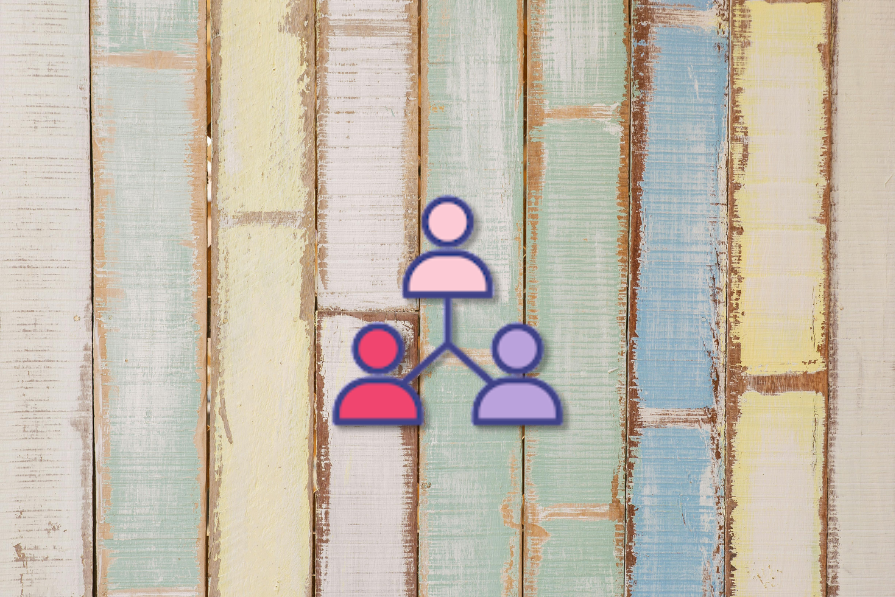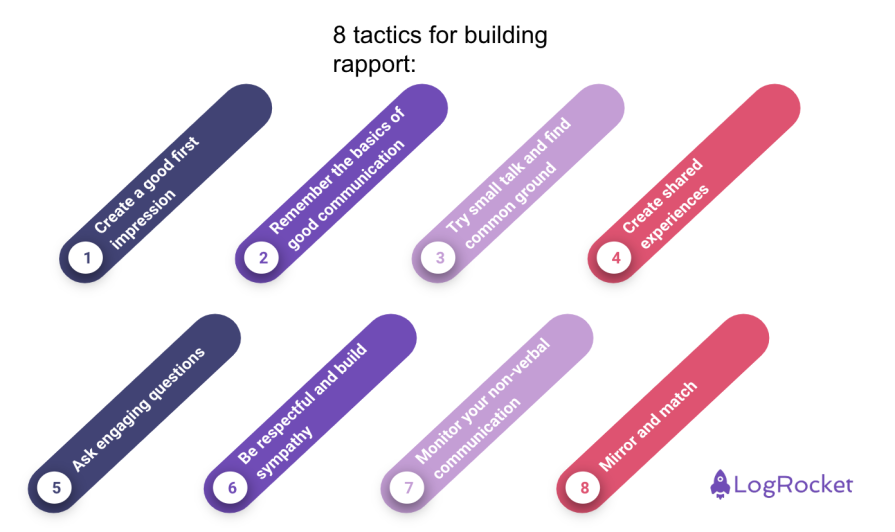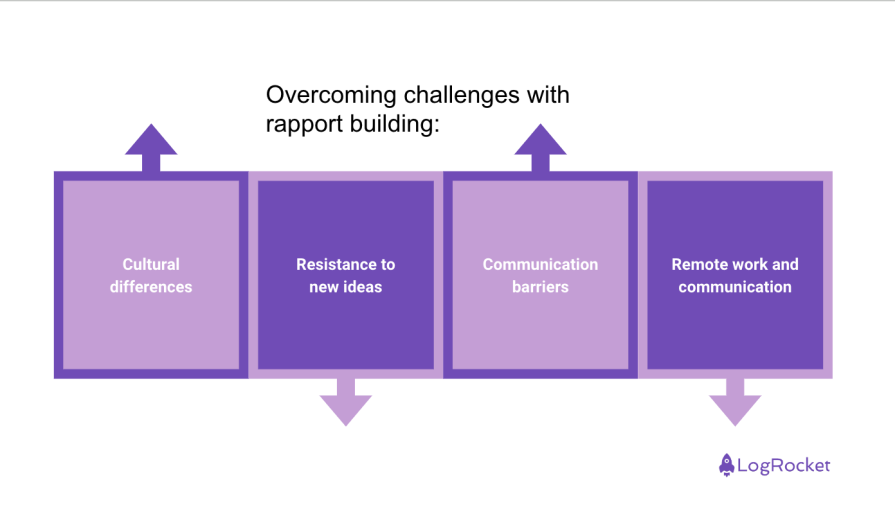Have you ever noticed when you’ve had dinner with friends or met up with them in a bar that everyone suddenly drinks from the glass at the same time? Perhaps you were with your family, engrossed in a conversation, and you noticed that you and the person you were talking to suddenly had the same posture. Or have you ever noticed that when one of your family starts yawning, everyone suddenly starts doing it and joins in?

This is the effect of mirror neurons and rapport. In this article, you’ll learn more about these two topics and explore how you can use rapport to your advantage in a professional setting.
Rapport is a friendly relationship that consists of agreement, mutual understanding, and empathy. This relationship makes interactions, communication, and negotiations easy between two people.
To build rapport you need to show empathy, listen actively, share common interests, and respond positively to the other person. This’ll help establish a connection that facilitates a smoother and more productive interaction.
Rapport is a two-way street; it connects two people. You can’t force rapport, but you can send the right signals and stimulate its development.
The following techniques are intended to help get you started. However, It’s important to tailor your approach towards the specific individual you want to build rapport with:

First impressions count and you only get one chance to make a good first impression. People tend to judge a book by its cover, so you should always dress a little better than the person you will meet. Make sure that you have a good first handshake and a nice smile. Keep eye contact and remember the person’s name.
Listen actively and ask engaging questions. Show interest in the other person and what they’re doing. Often address the other persons by their name. Hold your head up, keep a good posture, be concrete and correct, and stay in your character.
Identify some common ground and similarities in the first conversation. Try some small talk and build up a relationship before diving into the serious business talk. Ask questions and show interest in the other person’s life, as this will open up the conversation. Share some stories from your personal life and laugh together.
Human interaction builds rapport, which is why a great way to build rapport is to have some shared experiences. If possible, break up your routine and meet somewhere else. Go out and have an adventure together. In the business context, you can co-create something and share some work.
In every conversation, there should be a balance between asking and telling. That’s why asking engaging questions is so important in creating a good rapport. Think about the most important things you want to know from the other person and ask open questions.
Don’t just ask “Do you like my work?” but instead ask “What do you like most about my work?” Once you have identified what you would like to know, keep in mind that it’s better to talk less and listen more.
We are humans with human feelings. We can not suspend feeling things. That’s why we can use empathy to build rapport.
Empathy means that you understand other people’s feelings and emotions. So try to understand and share the other person’s emotions. Use active listening techniques and be a good listener.
Non-verbal communication plays a major role in a conversation. That’s why the tone in which you say something, the energy level you bring to the table, and your body language are so important. Try to:
Mirroring and matching the other person are powerful techniques to build rapport. People like others who are just like them.
We all have mirror neurons in our brains. These mirror neurons are responsible for your affection for similar personality traits. To use this effect to your advantage, you can:
Good product managers use rapport-building techniques to ensure the product’s success. You can use all the different techniques as discussed above in individual conversations with stakeholders, but let’s take a look at how you might approach building rapport among particular aspects of the business.
To better build rapport with the product development team you should ensure that everyone understands the product vision. Talking with the team about the vision and considering their standpoint may help to better build rapport.
Using inclusive discussion and decision-making will create shared responsibility and shared experiences. Recognize and acknowledge their hard work and achievements and help them overcome obstacles.
Involve the users in the design process. Use empathy and interview techniques to identify their needs. This will make them feel important and that will help you build rapport. Be transparent in your communication and whenever possible try to communicate with them in person.
With suppliers and partners, it’s helpful to underline the mutual benefits of your partnership. Show your suppliers your product and make sure they understand how they contribute to the success of the product. Maintain regular communication and try to meet in person.
It often helps to invite your suppliers and partners to collaborate in person and execute problem-solving together. Overcoming challenges together is a bonding moment that leads to good rapport.
Make your work, your vision, and goals transparent to management. Keep the management in a close loop but consider that their time is limited and a scarce resource. So keep your communication straight and short and prepare for every meeting. Build a good relationship and trust.
When it comes to building rapport, there are a number of factors that can interfere with the development of a good, working relationship. The following are some of the most common to keep an eye out for:

Working with people with different cultural backgrounds can be a challenge when it comes to building rapport. Misunderstandings can arise from cultural differences.
Educate yourself and the team about the cultural norms and communication style of your stakeholders or colleagues. Try not to be judgmental to other people and let go of stereotypes of any kind.
Stakeholders may be resistant to new ideas. This can make it hard to work with them and build rapport with them.
To overcome this situation you should listen actively and ask open questions about why they don’t like the new ideas. What kind of risks or problems do they see? Address these feelings and try to answer the questions they have. Over time you will convince them and build rapport.
Different communication patterns and preferences as well as language barriers can make it very hard to build rapport.
Meet in person and use all the different communication channels you have. The major part of communication is done via voice and body language. Smile, nod, and make encouraging sounds. Say the other person’s name and show empathy. Look the other person in the eyes and try to be empathic. This will help you overcome communication barriers.
Remote work is a great way to work from anywhere and get the job done, but it also can hinder the development of rapport. People often miss body language and facial expressions.
To overcome this situation, you should regularly meet in person. Have an in-person kick-off and maybe share an evening. That will help you kickstart your relationship and better build rapport.
In online meetings, make the most out of the technology and use video calls to foster face-to-face interactions. Call regularly and make small talk. Share some personal experiences and you will be more likely to build good rapport.
In my own professional life, I’m a software engineer. I was working for a company that took on the difficult task of developing an innovative product in cooperation with a customer. The project was characterized by challenging hardware-related software development and close cooperation with the customer. Since the customer had in-depth domain knowledge but was very skeptical about us, we were dependent on a good relationship with them. But the start of the collaboration was characterized by a difficult relationship with lots of mistrust.
At the beginning, the customer was distant, had no confidence in our abilities, and often micromanaged us. In every collaboration, even very technical ones, it’s the relationship that counts. So I realized that it was crucial for us to work on the relationship and that we needed a systematic approach to build trust.
We used rapport building techniques to create a real relationship. Our strategy was simple, we decided to focus as much as possible on real interaction — going beyond emails, talking face-to-face and meeting in person as much as possible. These personal conversations enabled us to better understand the pressure we were all under, especially our customer. Informal conversations also strengthened the relationship.
After completing the first important milestone, we decided to go out for dinner together. Away from the formalities and stress of work, there was now room for personal stories. We talked about our hobbies and families and were able to take our professional relationship to a new level in a relaxed atmosphere.
This was a turning point for the project and our collaboration. From then on, the client stopped micromanaging us all the time, they trusted us more and our achievements without constantly controlling everything. This change also meant that we could now work more efficiently and creatively as a team.
Building rapport is an essential skill in both personal and professional contexts. Effective rapport fosters trust, facilitates communication, and creates a foundation for successful collaboration and conflict resolution. It’s important to tailor your approach to understand the unique perspectives, needs, and communication styles of different stakeholders, whether they are team members, customers, investors, or community members.
Building Rapport builds trust and demonstrates your respect for their input and perspectives. Adapt your communication style to suit the audience, ensuring clarity and effectiveness. Be aware of potential challenges such as cultural differences, resistance to change, and conflicting interests.
Develop strategies to overcome these challenges, such as education on cultural norms, seeking win-win solutions, and building trust through consistency. Celebrate successes together and acknowledge the effort it took. Positive reinforcement can strengthen relationships and motivate continued collaboration and support.
Featured image source: IconScout

LogRocket identifies friction points in the user experience so you can make informed decisions about product and design changes that must happen to hit your goals.
With LogRocket, you can understand the scope of the issues affecting your product and prioritize the changes that need to be made. LogRocket simplifies workflows by allowing Engineering, Product, UX, and Design teams to work from the same data as you, eliminating any confusion about what needs to be done.
Get your teams on the same page — try LogRocket today.

Most teams fail at autonomy. Learn how clear rules help product teams move faster without micromanagement.

A practical framework for PMs to use AI in ideation without sacrificing judgment, strategy, or decision quality.

A practical five minute revenue estimation method to help product managers compare ideas, drop low impact features, and prioritize smarter.

A practical guide for PMs who want to stop being bottlenecks, delegate smarter, and lead teams effectively with a clear ownership framework.